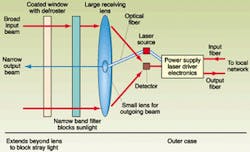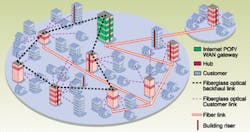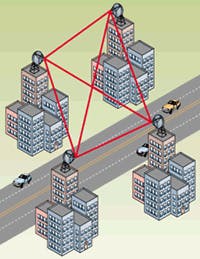
Atmospheric optical communication is undergoing a revival as a new generation of developers tries to fill difficult niches in metropolitan telecommunications. The demand for bandwidth is growing faster than network infrastructure, creating bottlenecks between high-speed networks inside of businesses and high-speed backbone systems. Optical fibers can provide the needed capacity, but only at the cost of time and considerable money to dig up the streets and lay new cables.
Sending laser beams through the air rather than through optical fibers can be an attractive alternative. Free-space laser transmission systems were first developed decades ago, but the technology languished with few applications. Now engineers have developed a new generation of atmospheric laser transmission systems. Ranging from point-to-point links to complex networks, they offer a new way to deliver high-speed communications in environments such as congested urban areas where lines of sight are much easier to find than cable routes.
Recycling an old idea
Sending optical signals through the air is not a new idea. Alexander Graham Bell demonstrated it using reflected sunlight with his Photophone in 1880. Nearly a century later, Bell Labs hoisted an early laser to the top of a microwave tower at its Murray Hill, NJ, headquarters to send pulses 40 km to its Holmdel site. However, experimenters quickly learned that air is nowhere near as clear as it seems. Air turbulence can bend beams far from distant receivers. Fog, snow, rain, haze and even passing birds can interrupt the beam, reducing the reliability of a long point-to-point link below the standards for backbone telecommunications. By 1964, a British military engineer bluntly concluded, "The atmosphere is completely inimical to laser transmission systems."1
In time, optical communication became almost synonymous with fiberoptics. Yet a scattering of short atmospheric links earned their place in specialized applications, typically connecting pairs of nearby buildings. Sending a laser beam through the air could avoid the high cost of laying a dedicated cable. Atmospheric laser links could be put into place quickly, and unlike point-to-point microwave systems, they did not require licenses from the Federal Communications Commission. However, reliability problems limited their applications.
The new generation of atmospheric systems has made great strides in improving reliability. Developers have demonstrated "four nines" or 99.99% reliability, meaning no more than one hour a year of outages. That falls short of the "five nines" or 99.999% target for telecommunications links, but it's good enough for many applications, particularly when atmospheric links are part of networks with other backup services. (It's also better than either my local telephone company or electric company managed this year.)
Atmospheric laser technology
Conceptually, an atmospheric optical link is simple, with a transmitter directing a laser beam at a receiver. The narrow beam concentrates power and makes eavesdropping very difficult, but it must be directed precisely to the receiver. Systems may include active alignment features, in which feedback from the receiver is used to help direct the transmitter beam to the optimum point. That both aids in installation and helps stabilize transmission between the tops of tall buildings, which can sway in the wind or in earthquakes. Typical beam divergence in a free-space laser link is 3 to 6 mrad, so the beam expands to only a few meters in diameter after traveling a kilometer. The collecting optics must strongly exclude ambient light lest sunlight or other illumination overwhelm the laser beam. In practice, the receiving optics have a narrow field of view and include narrow-pass filters that select the laser wavelength while blocking other wavelengths (see Fig. 1).
Transmission requires a clear line of sight between terminals. Usually this means the transmitter and receiver must be mounted on the roofs or sides of multistory buildings, or placed inside windows well above the ground. The beam should not pass close to trees or other obstructions that can move in the wind; it also should pass well above any passing vehicles and out of the paths of people. All outdoor equipment must be environmentally sealed to withstand extremes of weather, and external optics may need a defroster to remove frost or dew. Outdoor equipment also must be designed to discourage birds from perching on it, and to avoid collecting dirt or debris that could attenuate the optical signal.
The transmitters and receivers can use components adapted from their fiberoptic counterparts, with different beam-focusing and collecting optics. As in fiberoptic systems, two-way transmission requires one transmitter and one receiver at each end; they may be separate or built into the same package.
Current systems operate at a variety of wavelengths; the usual choices are 780, 850 and 1550 nm. Wavelength-division multiplexing is possible, but rarely used. The main concerns in the choice of wavelength are eye safety and laser cost. The eye does not transmit the 1550-nm wavelength of long-haul fiberoptic systems to the retina, so lasers emitting up to 10 mW at that wavelength are considered as eye-safe Class 1 products. On the other hand, 1550-nm lasers are far more expensive than lasers emitting at 780 or 850 nm, in which the maximum power for Class 1 operation is a fraction of a milliwatt. Somewhat higher powers can be used as long as the beams are kept out of human reach, but such transmitters require automatic power-reduction systems, which monitor received power and quickly reduce output to Class 1 level if anything interrupts the beam. The main concern is maintenance workers on rooftops rather than passing birds.
Point-to-point access systems
The main selling points of atmospheric laser links are their lower cost and much faster installation time than dedicated fiberoptic links with the same bandwidth. Current atmospheric links transmit signals from about 100 m to a few kilometers at standard transmission rates such as 155 Mbit/s and 622 Mbit/s; systems for Gigabit Ethernet and higher speeds are in development. Atmospheric links have standard fiberoptic interfaces at both ends, so the rest of the system doesn't "know" if the signals go through the air or through a fiber.
Considerable engineering goes into increasing reliability. Small-scale atmospheric turbulence causes laser beams to fluctuate in both intensity and direction, an effect we see as laser speckle. To prevent this effect from introducing noise into the signal, multiple lasers can be mounted in a single laser head, spaced about 20 cm apart. All lasers are modulated with the same signal, but the beams experience different scintillation because they travel different paths, so at least one of them should reach the receiver with adequate power.
Performance also improves with adaptive power control, which adjusts output power to match local conditions. When the air is clear, the transmitters send a low-level signal with a safety margin to ensure it will be received reliably. If the weather starts to attenuate the beam, the receiver detects reduced power and signals the transmitter to increase its output to compensate for the higher attenuation, ensuring that enough power reaches the receiver.
Applications of such point-to-point atmospheric links can go well beyond the stereotypical example of linking two tall office buildings on opposite sides of a busy highway. Several links can radiate from one building with dedicated fiberoptic line to buildings that don't have their own fiber connections. Atmospheric links also can serve as protection circuits for fiberoptic systems; failure of the fiber circuit switches the signal to the atmospheric link. The free-space backup could ease the anxieties of network administrators who tend to worry every time they see a backhoe.
A major potential application is enhancing the bandwidth of connections from local cellular-phone antennas to their switching centers. Current wireless systems connect to individual handsets at data rates to 44 kbit/s, so a single 1.5-Mbit/s T1 copper telephone line can serve a local antenna. Next-generation wireless handsets are supposed to handle up to 384 kbit/s, however, generating a load far beyond the capabilities of copper T1 lines. Wireless network operators are looking to atmospheric laser links to avoid the high cost of running fiber to every antenna. The T1 line could remain as a backup, in case weather foul enough to block a laser path through the air didn't convince everyone to stay at home.Point-to-multipoint and mesh networks
Numbers of point-to-point atmospheric links can be assembled into optical networks that distribute signals among many buildings in the same area.One approach is the point-to-multipoint design, which essentially replicates a conventional fiberoptic distribution network (see Fig. 2). Optical fibers run from a switching office or other central point to one or more buildings in a group connected by a set of high-speed atmospheric links that form a ring. As with fiber rings, the ring architecture provides redundancy, so all the major nodes remain connected even if one interbuilding link is interrupted. Each of these major building nodes, in turn, distributes signals over atmospheric optical links to other buildings at lower speeds. Typically these secondary customers lack a redundant atmospheric link to their building, but retain a copper link or some other backup connection to the network that can provide lower-speed service in case of an emergency.
An alternative approach is the mesh network (see Fig. 3). The mesh is actually an array of point-to-point links, arranged to form multiple connections among all points. Interrupting one or even a few of these links would leave other routes through the mesh to make the same connection.
The main applications for atmospheric optical networks are in dense urban areas studded with buildings at least several stories tall, where construction is difficult and expensive. In such environments, point-to-point links may need to be no more than a few hundred meters long, improving system reliability.
Prospects up in the air
The future of atmospheric optical networks is up in the air in many ways. Despite encouraging demonstrations in such difficult environments as Seattle, the technology has yet to be widely deployed, so some problems may remain to be shaken out. The trade-offs among transmission wavelengths and network architectures have yet to be established. Likewise, operating experience has been too limited to establish the trade-offs among distance, environment, and reliability.Atmospheric laser systems seem likely to capture a larger niche in the communications market. The prospects look best in dense downtown areas. The big question is how much farther they can go.
ACKNOWLEDGMENT
Thanks to FSONA Communications, LightPointe Communications, AirFiber, and TeraBeam Communications.
REFERENCE
- R. Meredith, Conference on Lasers and Their Applications, "Unguided optical propagation in the atmosphere and under-sea" (Institution of Electrical Engineers, London; September 1964).
A satellite built to test these concepts is finally in orbit. In May, the National Reconnaissance Office launched the Geosynchronous Lightweight Technology Experiment (GeoLITE), which carries a surface-to-satellite laser communication experiment.
About the Author
Jeff Hecht
Contributing Editor
Jeff Hecht is a regular contributing editor to Laser Focus World and has been covering the laser industry for 35 years. A prolific book author, Jeff's published works include “Understanding Fiber Optics,” “Understanding Lasers,” “The Laser Guidebook,” and “Beam Weapons: The Next Arms Race.” He also has written books on the histories of lasers and fiber optics, including “City of Light: The Story of Fiber Optics,” and “Beam: The Race to Make the Laser.” Find out more at jeffhecht.com.


